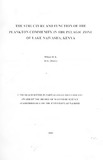| dc.description.abstract | In Lake Naivasha minimal fish predation upon the zooplankton due to low fish biomass and the absence of true
planktivorous fish is suspected, from previous studies. The relative importance of the two forces, top-down and
bottom-up control, on the structuring and interaction of the plankton community in Lake Naivasha was evaluated
to test this assumption. Analyses of plankton (phytoplankton and zooplankton) were conducted on data obtained
from three stations in Lake Naivasha at Crescent Island Lagoon, Main Lake and Oloidien basin (St 1, St 2 and St
3 respectively) between May 1995 and April 1996. Physico-chemical parameters were measured alongside
plankton sample collection.
The lake water surface temperature measured between 9.00am and 10.00am ranged between 19.5 "C and 23.5 -c
declining gradually towards the bottom. The mean dissolved oxygen concentrations ranged from 6.0 mg. r' and
7.4 mg.l'. The electrical conductivity of the lake water at St 1 and St 2 fluctuated between 320flS/cm and
420flS/Cm. At St 3 the conductivity was higher and ranged from 2470flS/cm to 2850flS/Cm.
The Secchi disc water transparency depth decreased with increase in phytoplankton biomass. The mean Secchi
disc transparency depth was 72cm at St 1, 61cm at St 2 and 27cm at St 3. The phytoplankton biomass (measured
as chlorophyll-'a' mg. m") was highest at St 3 (112.3 ± 27.1 mg. mI·3) than at St 1 and St 2 (36.1mg.m·3 and
30.8mg.m·3 respectively).
The phytoplankton community was dominated by filamentous net phytoplankton (cell size >20flm). At St 1 and
St 2, Chlorophyta species mainly Cosmarium, Oocystis, Scenedesmus and Tetraedron dominated the
phytoplankton density and contributed an average of 40% (285 cells ml') and 45% (264 cells ml') respectively.
At St 3, the Bacillariophyta species (Synedra, Aulacosiera and Nitzchia) were the dominant and represented
43% (2913 cell ml") of the mean total phytoplankton cell density. Limited nannoplankton «20flm) represented
by the taxa Chroococcus, Cosmarium, Oocystis, Tetraedron, Chromulina, Trachelomonus and Cryptomonus
were encountered.
Crustacea dominated the zooplankton community, contributing 71%, 60.5% and 90.4% of the total density at St
1, St 2 and St 3 respectively. The species Thermocyclops oblongatus was the most dominant species in all
stations throughout the study period. At St. 3 the zooplankton density (9.7x105 m') was higher compared to that
of St 1 (3.2x105 m') and St 2 (7.6xl05 m"). Similarly the zooplankton biomass, expressed as dry weight was
highest at St 3 (473.8 dry wt. mg. m') compared with St 1 (278.6 dry wt. mg. m') and St 2 (204.4 dry wt. mg.
m")
The zooplankton body sizes ranged from 66flm to 2040flm. The occurrence of large bodied zooplankton species
(Thermo cyclops oblongatus Daphnia pulex, Diaphanosoma excisum, Simocephalus vetulus) suggested low
utilisation by fish. There was thus no direct influence of predation in the structuring of the zooplankton and in
turn that of the phytoplankton. | en |

